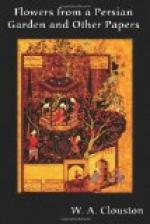The incident of fruit or food being poisoned by a serpent is of frequent occurrence in Eastern stories; thus, in the Book of Sindibad a man sends his slave-girl to fetch milk, with which to feast some guests. As she was returning with it in an open vessel a stork flew over her, carrying a snake in its beak; the snake dropped some of its poison into the milk, and all the guests who partook of it immediately fell down and died.—The Water of Life and the Tree of Life are the subjects of many European as well as Asiatic folk-tales. Muslims have a tradition that Alexander the Great despatched the prophet Al-Khizar (who is often confounded with Moses and Elias in legends) to procure him some of the Water of Life. The prophet, after a long and perilous journey, at length reached this Spring of Everlasting Youth, and, having taken a hearty draught of its waters, the stream suddenly disappeared—and has, we may suppose, never been rediscovered. Al-Khizar, they say, still lives, and occasionally appears to persons whom he desires especially to favour, and always clothed in a green robe, the emblem of perennial youth. In Arabic, Khizar signifies green.
* * * * *
The faithful and sagacious Parrot having entertained the lady during fifty-two successive nights, and thereby prevented her from prosecuting her intended intrigue, on the following day the merchant returned, and, missing the sharak from the cage, inquired its fate of the Parrot, who straight-way acquainted him of all that had taken place in his absence, and, according to Kadiri’s abridged text, he put his wife to death, which was certainly very unjust, since the lady’s offence was only in design, not in fact.[53]
[53] In one Telugu version, entitled
Toti Nama Cat’halu,
the
lady kills the bird after hearing all its tales; and
in
another the husband, on returning home and learning
of
his wife’s intended intrigue, cuts off her head
and
becomes
a devotee.
* * * * *
It will be observed that the frame of the Tuti Nama somewhat resembles the story, in the Arabian Nights, of the Merchant, his Wife, and the Parrot, which properly belongs to, and occurs in, all the versions of the Book of Sindibad, and also in the Seven Wise Masters; in the latter a magpie takes the place of the parrot. In my Popular Tales and Fictions I have pointed out the close analogy which the frame of the Parrot-Book bears to a Panjabi legend of the renowned hero Raja Rasalu. In the Tuti Nama the merchant leaves a parrot and a sharak to watch over his wife’s conduct in his absence, charging her to obtain their consent before she enters upon any undertaking of moment; and on her consulting the sharak as to the propriety of her assignation with the young prince, the bird refuses consent, whereupon




